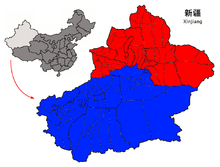Altishahr
The term means "Six Cities" in Turkic languages, referring to oasis towns along the rim of the Tarim, including Kashgar, in what is now southern Xinjiang Uyghur Autonomous Region of China.
[12] In the 18th century, prior to the Qing conquest of Xinjiang in 1759, the oasis towns around the Tarim did not have a single political structure governing them, and Altishahr referred to the region in general rather than any cities in particular.
[13] According to Albert von Le Coq, the 'Six Cities' (Altishahr) referred to (1) Kashgar; (2) Maralbexi (Maralbashi, Bachu); (3) Aksu (Aqsu), alternatively Kargilik (Yecheng); (4) Yengisar (Yengi Hisar); (5) Yarkant (Yarkand, Shache); and (6) Khotan.
[13] The term 'Eight Cities' (Uyghur Cyrillic: Шәкиз Шәһәр, Şäkiz Şähār) may have been a Turkic translation of the Qing Chinese term Nanlu Bajiang (literally 'Eight Cities of the Southern Circuit'), referring to (1) Kashgar, (2) Yengisar (3) Yarkant and (4) Khotan in the west and (5) Uqturpan, (6) Aksu, (7) Karasahr (Qarashahr, Yanqi), and (8) Turpan in the east.
Until the 8th century AD, much of the Tarim Basin was inhabited by Tocharians who spoke an Indo-European language and built city states in the oases along the rim of the Taklamakan Desert.
The Qing initially administered the Dzungaria and Altishahar separately as the Northern and Southern Circuits of Tian Shan, respectively,[14][15][16][17] although both were under control of the General of Ili.



